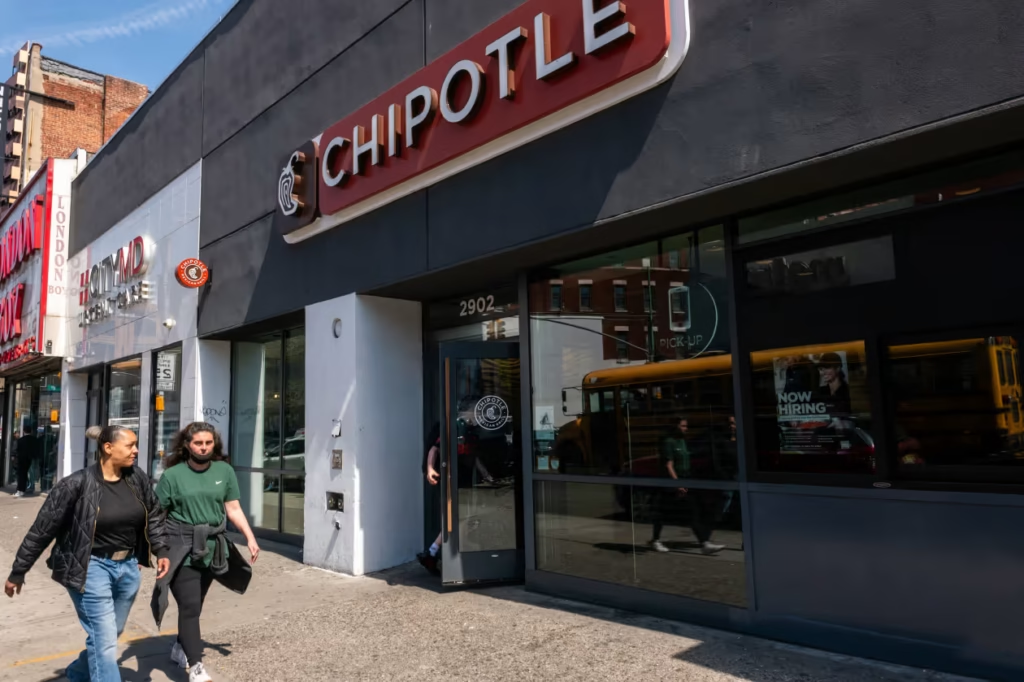Wall Street was looking for reasons to be hopeful about the remainder of the year after Chipotle Mexican Grill Inc. shocked them on Wednesday with its first quarterly same-store sales decline since the pandemic lockdowns in 2020.
Following those findings, some experts expressed optimism on the possibility of new menu items and summer-season marketing. Others, however, voiced worries about the equipment Chipotle (CMG) is depending on for quicker service, the lack of equipment and increased supply costs, and the construction of new restaurants.
Following years of price increases and new economic uncertainty, the fast-casual Mexican chain’s first-quarter results showed yet another decline in consumer spending. Daily shifts in trade talks since the announcement of new U.S. tariffs earlier this month have kept consumers and businesses in suspense and have the potential to push prices further higher.
During the first quarter, Chipotle’s same-store sales decreased by 0.4%. During the company’s earnings call on Wednesday, CEO Scott Boatwright stated that the “overwhelming reason” why customers were coming to the restaurant less frequently was economic anxiety. Executives pointed out that the U.S.’s 10% import tax for many countries and aluminum tariffs could have a negative impact on profitability.
Fast-casual restaurants, which aim to combine quick service with better products, managed to survive last year after competitors’ pricing hikes backfired. As the restaurant chain increases its efforts in digital marketing, loyalty programs, and a possible new menu item—possibly a side or a dip—Chipotle will still be able to maintain its competitiveness, according to analysts at Truist Securities on Wednesday. They pointed out that the chain’s recently launched, time-limited Honey Chicken product was still well-liked.
According to the Truist analysts, Chipotle’s short-term profit margins may be impacted by tariffs and the company’s investments. They did, however, note that operational costs are still “tame” and that margins should grow in the second half of the year.
“We remain confident that [Chipotle] is relatively well positioned to gain share as consumer spending slows, given its compelling value,” they stated.
Other analysts pointed out that in the second half of 2025, it will be easier to compare sales year over year, which could result in a lower bar for growth. The spring “burrito-selling season”—which is frequently a busy time for the chain—was also mentioned by BofA analysts as a possible plus in a note released on Thursday.
Additionally, they pointed out that guacamole or queso are added to half of Chipotle’s orders. They agreed with the Truist experts that a drop or new side may boost sales as well.
Chipotle’s stock increased 1.6% on Thursday. However, while the company presses on with opening new stores and bringing in new equipment to process orders more rapidly, other analysts were concerned about the impact of tariffs, and the stock has down 20.7% over the last 12 months.
Chipotle has not altered its plan to open between 315 and 345 new locations this year. Produce slicers should be at every Chipotle restaurant by the end of the second quarter, according to a research note released on Thursday by William Blair analysts. Later in the year, the company wants to install dual-sided grills, rice cookers, and dual-vat fryers in new locations.
However, in a note published Thursday, BTIG analyst Peter Saleh stated that tariffs would increase the cost of constructing new stores by $65,000 to $75,000 each. He added that as the trade war creates concerns about supply chains and product availability, there are more pressing issues to be concerned about.
“We remain more concerned about the potential for shortages for everything that goes into building a restaurant, from lumber, HVAC, electrical components and kitchen equipment,” he stated. “Management stated that they were not experiencing or learning of any supplier shortages, but we are nonetheless worried because of how unstable the situation is right now.
“While a lot of equipment is manufactured in the USA, the electrical components come from China and other tariffed countries,” Saleh continued.





